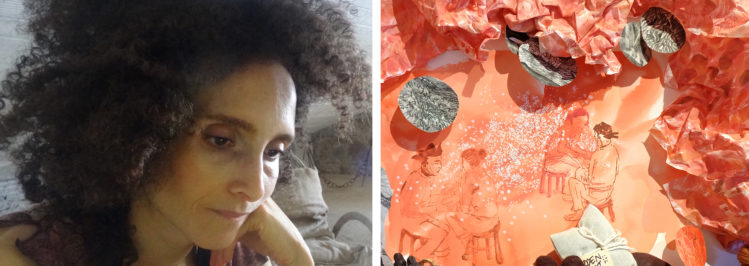
In Conversation: stories and myths we tell ourselves about ourselves and others.
A conversation between artist Lucie Chan and Centre A’s Curatorial Assistant Intern Alexandra Tsay.
Art is a mythology of our currents––some art, some currents. Myth is a traditional story of allegedly historical events that serves to unfold part of the worldview of people or explain a practice, belief, or natural phenomenon. In the past, people used myths to make meaning out of the mysteries of the world they lived in, or to explain the world to themselves through the stories of gods and supernatural creatures. The world has transformed, changed, and happened to be a less enigmatic place, but contemporary artists use art to remind us there are still mysteries in the world we live in. Human beings are one of them. I believe the narrative of art as the mythology or the body of alternative knowledge that unfolds, explains, examines, and questions the current moment is one of the frameworks to look at, experience, and appreciate works of contemporary artists, and Lucie Chan is one of them.
I met with Lucie over Zoom; the pandemic over the past year and a half proves that online conversations can still feel unexpectedly warm as a real encounter (do we know what is real anymore?). Lucie is a Guyana-born Canadian artist and a professor at Emily Carr University of Art and Design. She presented an exhibition, To Be Free, Everything You Most Hate and Fear?, at Centre A in January 2020. Lucie creates assemblage-like objects combining various artistic media and materials into both grandiose and fragile installations. We have talked about her artworks and what inspires them, about what it means to see and be seen, and how signifiers of identity both reveal and hide who we are.
“My art reveals a mass confusion of being a human being.”
Lucie: Sometimes I feel that people want to put me into a specific box or a particular way of thinking about things. My work is often about retelling stories. I have had a long career of interviewing strangers and sometimes people I know. I am interested in these interactions when something is revealed that we don’t necessarily have every day like a sense of connection or intimacy that doesn’t exist or is impossible to happen if you live in a big city because we are humans, and we have boundaries and mutual expectations.
I am interested in the translation of what happens when I interact with people who do not necessarily have their voices heard in an intimate way. Instead, I have always been interested in what you are not supposed to do. You are not supposed to retell the stories of others, and I have always been interested in that, because I think there is something about oral histories and carrying someone else’s narrative in order to try to create some really deep work that embodies these stories. I really treat time together as beyond research, as process. I am thinking of how without art I would never have this and without that person I would have a harder time to change as an artist.
Alexandra: How do you meet those people? How do you choose them?
L: It starts with choosing the interviewees. I am very introverted and shy; for months and months, I can just observe people in the library or at my community gym that I think look interesting. I do the exact thing that I hate people doing to me: people think she looks interesting, she looks ethnic or looks like she is from somewhere else. I reversed the role. I am trying not to ask friends for conversations, instead, I am trying to ask people who don’t know me — that way, we don’t owe each other anything, we are strangers, or in artistic residencies I invite people, and we don’t know much about each other, but we just sit and talk, and for me, as a shy person it’s amazing that people sign up to do that.
A: What are your conversations about? Do you have a prepared set of questions or is it a spontaneous dialogue?
L: Sometimes I have prepared questions that I don’t quite know the meaning of. For example, once the question was: teach me a cultural lesson. I was in Canada at the time, the people I interviewed were all from different backgrounds. We immediately laughed together, and they opened up and told me things I have never heard of.
When I was in Halifax, no one would believe that I have the last name “Chan” and that I could possibly be half Chinese. But then I said: “Teach me or make me more Asian”, and we didn’t even know what that was. There were Chinese, Korean, Japanese people, immigrants and Chinese-born Canadians, and we were just talking about how or if Asian culture could include this: when we just go to the yard and lay on our backs and scream and be really inappropriate and have an hour of that a day. Could it be Asian? What does it mean to be Asian? Those questions were a bit traumatizing for me, because people could look at my skin or grab my hand and ask what part of China I was from, what my Chinese name was.
I realized that people I was speaking to were taking risks by exposing something about themselves, too. They were telling me that, “We are not interested in this, because we are not just Chinese or Japanese or Canadians, we are so much more.” I am interested in that, and ways in which we can arrive somewhere else. We are all immigrants in Canada, no one is similar to another person. I am more interested in those nuances and surprises that are not always on the surface or great; it’s awkward. I think it’s important to sit through that too. I think it is a part of problem-solving through art.
A: How do you translate those stories and encounters into artistic practice?
L: Writing is a huge part of my process; I sit and write, and have a very condensed narrative. For a long time, I would ask different people to read these narratives, and because of their accents, or because they went through something similar, they all sound different. It is actually very beautiful, as we read these stories out loud to a young person, and they imagine something. I create installations with different images, sculptural elements, photographs, and audiovisual elements as well. I am trying to combine different artistic elements to reveal the complexity of being human. The translation always shows multiple aesthetics and connections and fused relationships between aesthetics — sound, video, image and that is the way of showing how layered and complex people are. My art is about the mass confusion of being a human being.
When I ask people to teach me a cultural lesson, we can meet several times and talk, and when the project is done, I spend more time sitting and talking to them further. I think it is a cultural lesson to talk to a person about not simply about where they were born, or if their parents were first-generation immigrants. It is obvious to us, but not everyone sees and understands that cultural identity is not actually the core side of people.
A: Do you think that, for an immigrant or an immigrant artist, it is possible to be seen out of that cultural box? You are seen as a part of your bigger identity whatever it is, whatever people have in mind and then if you want to jump out of that box it can be very difficult.
L: I immigrated here at a young age, I always looked at my parents and thought about how difficult it must be in your early 30s, to leave your home country, have two kids, leave behind almost all of your belongings and move to a new country. It is difficult even at a young age. If you are an immigrant, it is difficult to be seen outside of your box, or what people think you are bringing with you, or what you embody. I really think it is one of the most essential human experiences, especially in Canada. I moved here in the year of the Multiculturalism Act, so suddenly, that was on my mind from a very young age. Now I see that people of different ages, have never been seen or are seen through very specific frames. I think it is my responsibility as an early immigrant to say that it is essential for Canadians and immigrants who arrive here to have a choice of what they can be and what their life could be.
A: Can art help with breaking those frames of seeing each other and opening new ones?
L: I am a teacher, so I bring in artists who represent some of the students who don’t usually get to be represented, and they come to me and say: “I didn’t know you can be from the Philippines and make art about the Philippines” or “I didn’t know you can be from Salvador and make art about your country.” For me, it’s a heartbreaking and important moment to realize how essential it is that we are not stuck in a bubble and let people create whatever they feel needs to be created.
I truly feel it’s one of the most critical things and I thrive not only as an artist but as a teacher — I tell my students to not only look at artists who are taught within the canon, but also look at the amazing things that people have been doing for ages before Canadians have been doing this.
A: Why is drawing important for your practice? Was it somehow connected with stories? Is there any connection between stories and drawing?
L: It started as a very practical thing, I was at the art school and I liked animation, sculptures, and drawing. I liked the idea of drawing because I wasn’t rich. I actually didn’t have much money, and I was afraid when I left art school I wouldn’t be able to be an artist because I didn’t have any equipment. I just said to myself that I didn’t want to go out into the world after that special time in art school and not have access to those things and not be able to make things. Drawing was something that people usually do before they move to the next thing and people usually say to me: I have all those beautiful papers from when I used to draw, but now I am making sculptures. All these drawing materials came to me freely, and I didn’t buy any supplies for about five years after graduating from school. People were giving them to me.
Now I think there is something very powerful in drawing, it allows you to be very humble in response to materials in a way that what you did when you were very young. When I started drawing I didn’t have a plan, I had ideas, but it is not like a recipe, it is more like a slow process that doesn’t connect with the outside world. It is like a meditation and I like to start as an exploration of what a drawing can be instead of drawing as masters did.
A: Did you draw from a young age?
L: I have been drawing since I was young. When I was bored and I wanted to go outdoors to play, my father made me write or draw, maybe related to his own visual and writing practices, but also to keep an eye on me.
A: You somehow also combine storytelling, voices and sound,
L: Yeah, my father didn’t go to art school but was always creating and being inventive in all aspects of his life, and I didn’t know that being an artist is something you can do seriously. My surroundings had an impact on all of my senses. Maybe indirectly, even though our works look very different, I am affected by stories, voice, sound. Thank you for making this connection for me.









